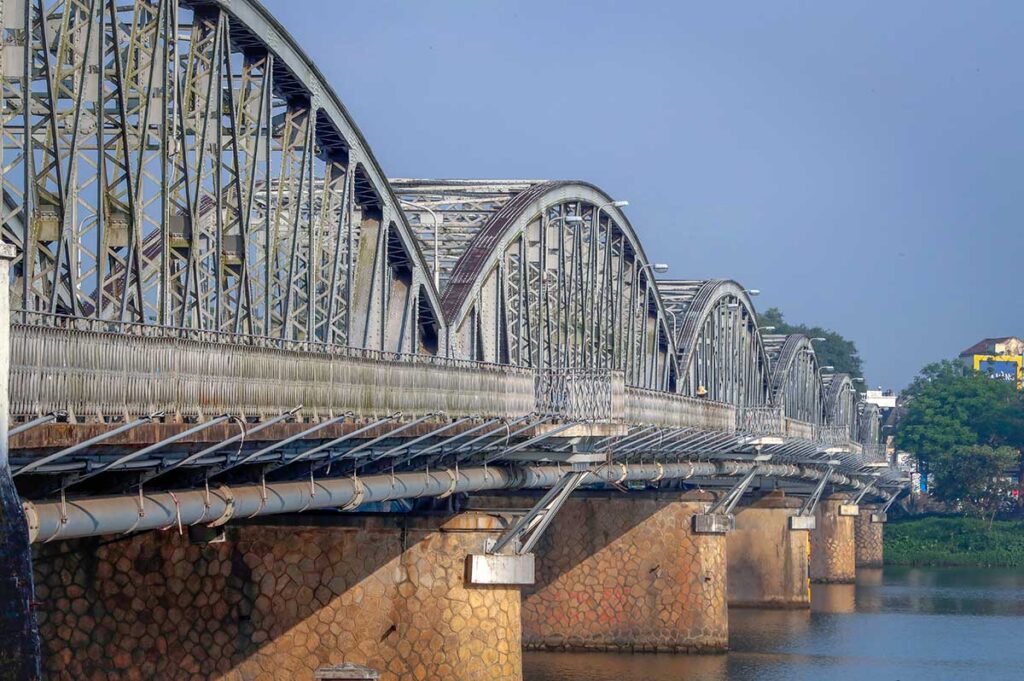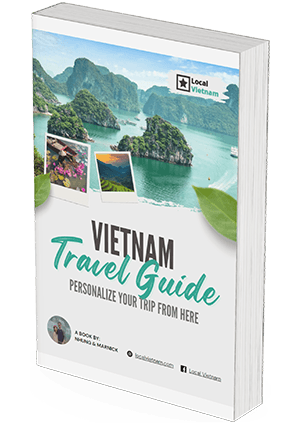What is Trang Tien Bridge like?
Trang Tien Bridge is one of the most famous landmarks in Hue. It crosses the Perfume River and connects the old Imperial City on the north side with the modern center on the south. Built over 100 years ago during the French colonial era, the bridge has a long and interesting history.
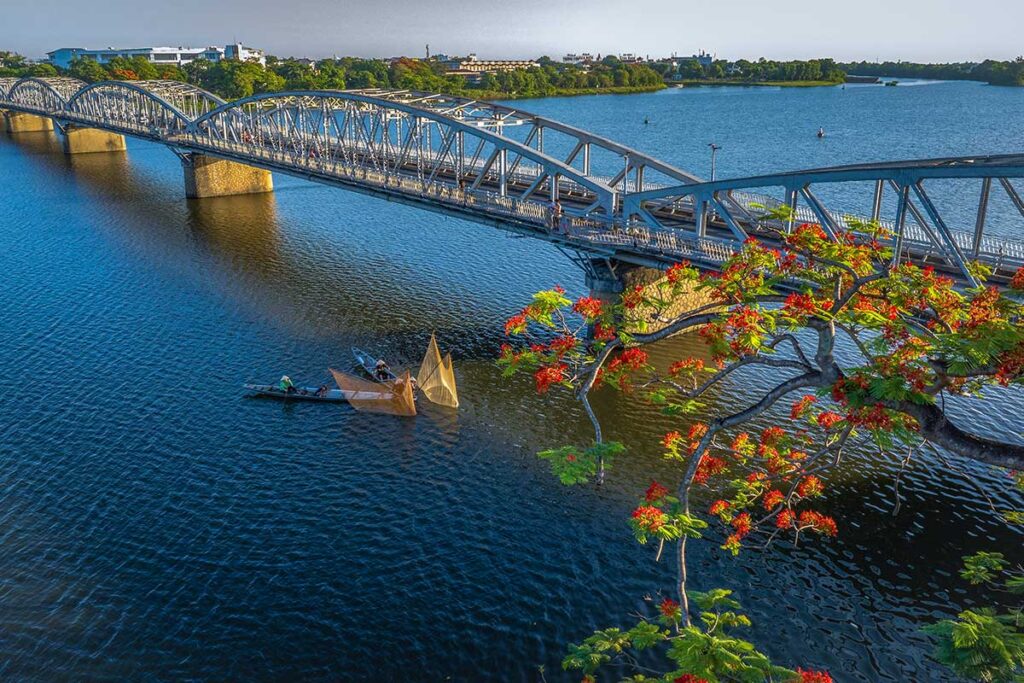
Today, it’s used by locals every day and is especially beautiful at sunset or when lit up at night. Whether you walk across it, see it from a boat, or just relax nearby, the bridge offers great views and a real feel for the city.
History of Trang Tien Bridge
Colonial beginnings
Trang Tien Bridge was commissioned by King Thanh Thai in 1896 and constructed between 1897 and 1899 by the Eiffel company—the same firm behind the Eiffel Tower. It was the first steel bridge in Indochina, built using imported materials and modern Western engineering methods, making it a major feat at the time.
Name changes over time
Over the decades, the bridge has reflected the political changes shaping Vietnam.
- 1899 – Opened as Thanh Thai Bridge, named after the Vietnamese emperor.
- 1919–1945 – Renamed Clémenceau Bridge by the French colonial government.
- 1945 – Briefly renamed Nguyen Hoang Bridge under the administration of Tran Trong Kim.
- Post-1975 – Officially known as Truong Tien Bridge, referencing a former coin mint located nearby.
- Today – Often called Trang Tien Bridge by locals. Both names are still used interchangeably, and you’ll see signs for either depending on where you are.
Damage and restoration
The bridge has survived its share of hardship, including multiple floods and damage during the Vietnam War, especially in the Tet Offensive of 1968.
It was fully renovated in 1995, and in 2002, a system of color-changing LED lights was added—giving the bridge a completely new look at night and turning it into a nighttime focal point for visitors and locals alike.
Bridge design and structure
Trang Tien Bridge stands out for its Gothic-inspired steel design, blending colonial-era elegance with sturdy engineering. Built entirely with materials imported from the West, it was a symbol of modernity when it first opened.
The bridge measures 402.6 meters in length, 6 meters wide, and 5.45 meters high. Its structure consists of six steel girder spans, each 67 meters long, connected by 12 graceful arches that give the bridge its distinct silhouette.
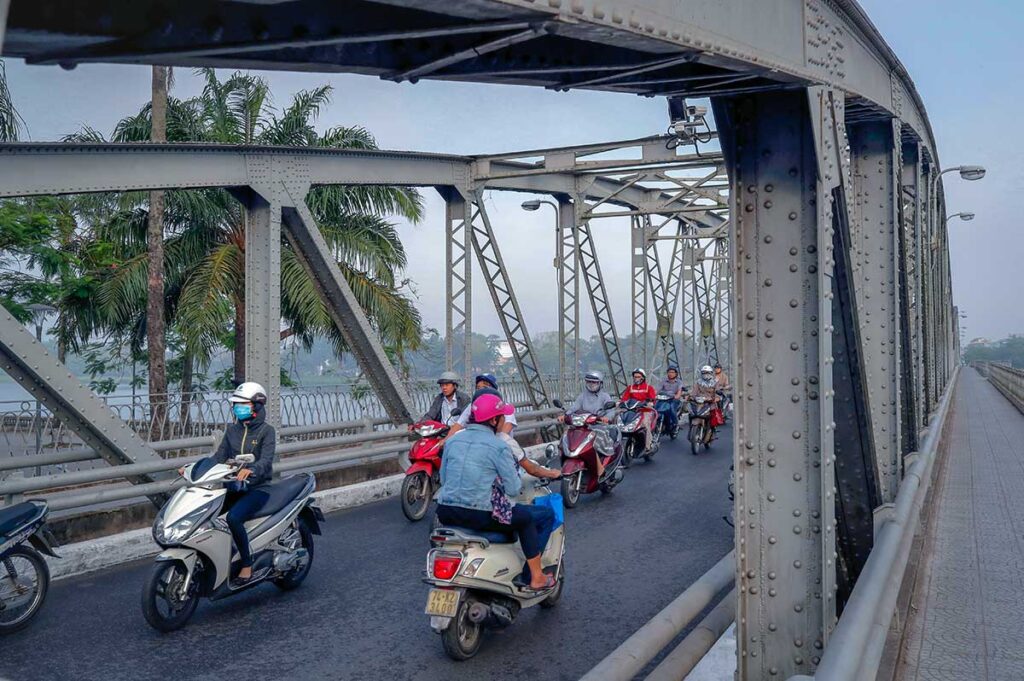
While it once carried cars, bikes, and even horse-drawn carriages, today it’s used mainly by pedestrians, motorbikes, and bicycles. From the bridge, you get wide views of the Perfume River, with some of the best moments coming at sunrise or sunset, when the light reflects beautifully off the water.
Trang Tien Bridge also plays a practical role: it connects the southern side of Hue—where you’ll find most hotels, restaurants, and shops—with the northern side, home to the Imperial City, Dong Ba Market, and several historic sites. Whether you’re sightseeing or just crossing town, you’ll likely use this bridge more than once during your stay in Hue.
What to see and do at the Trang Tien Bridge
Trang Tien Bridge isn’t a major attraction in terms of activities, but it offers plenty of atmosphere, views, and local life. Whether you’re walking, cycling, or just passing by, it’s one of those places that gives you a real feel for Hue.
1. Walk across the bridge

The most classic way to experience the bridge is simply to walk across it. Locals and travelers alike use it every day—some stop to take photos, others just enjoy the view over the Perfume River and the gentle breeze.
It’s especially nice in the early morning, when the light is soft and the city is quiet, or in the late afternoon, when golden-hour colors reflect on the water.
Tip: You can also ride across in a cyclo for a more relaxed experience or use a bicycle if you’re exploring Hue on two wheels.
2. See the bridge at night
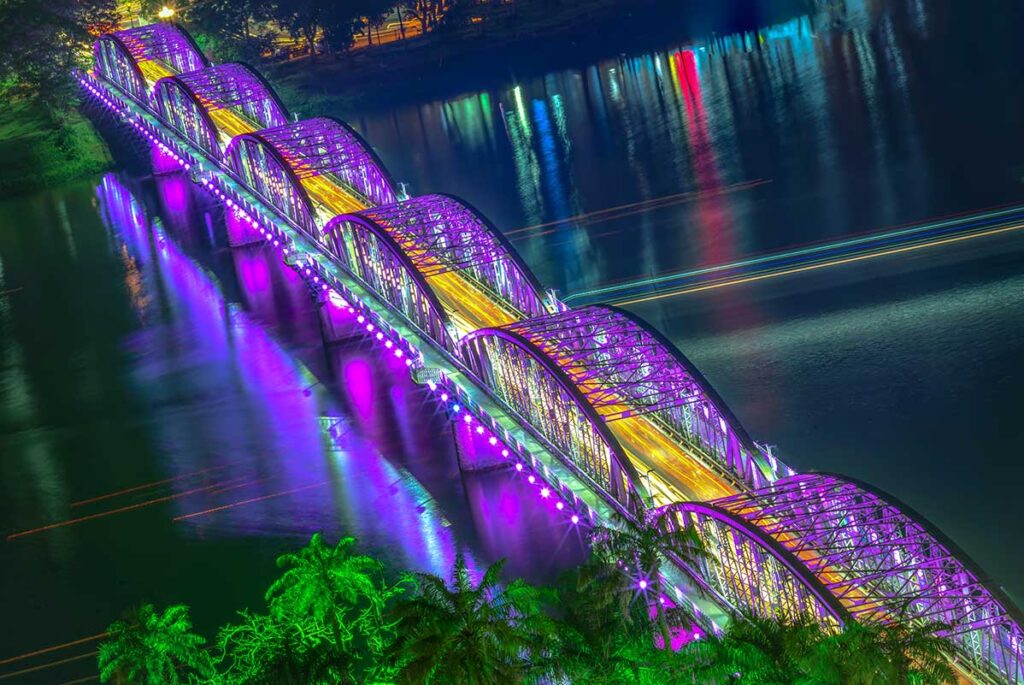
Trang Tien really comes alive in the evening. Thanks to a color-changing LED system installed in 2002, the bridge lights up in shades of purple, blue, and green, casting reflections onto the Perfume River below.
The area around the bridge often fills with young locals, couples, and families—walking, chatting, or taking photos. On some nights, you might hear the soft sounds of ca tru or folk music floating across the water from nearby dragon boats.

Along the riverbanks, especially near the south end, there’s a riverside promenade where informal food stalls and souvenir stands appear—more so on weekends or during festivals.
3. Take a dragon boat ride
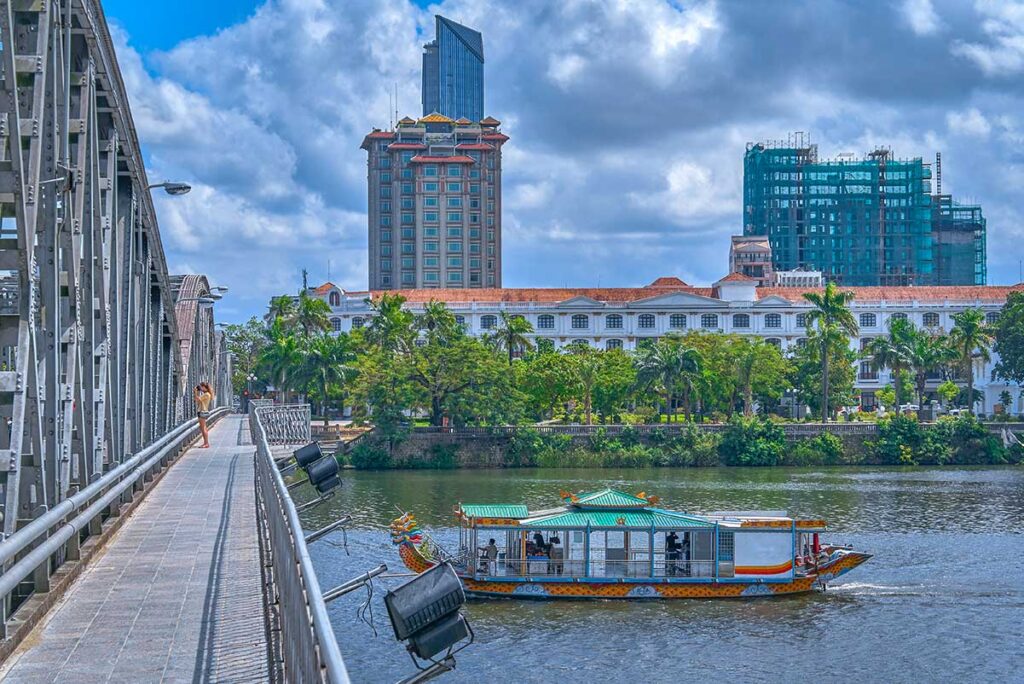
If you want to see the bridge from the water, dragon boat rides are easy to arrange from docks near the bridge. Most trips pass underneath Trang Tien before continuing down the Perfume River toward Thien Mu Pagoda, the Imperial Tombs, or just a slow, scenic cruise.
Evening rides can be especially charming, with music onboard, soft lighting, and a chance to see the bridge glowing from the river. Sunset is the best time if you’re looking for photos or a romantic setting.
4. Relax by the riverside
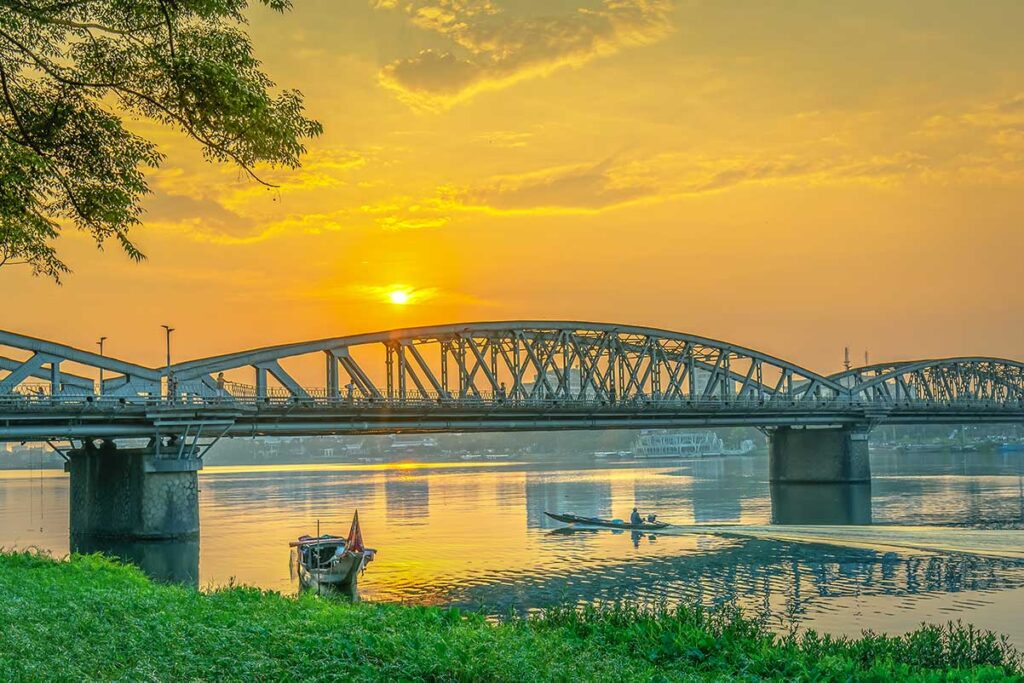
You don’t even have to cross the bridge to enjoy it. Both sides of the river have quiet seating areas and parks, perfect for relaxing.
On the north side, Thuong Bac Park offers benches and shade, while the south side has a well-kept walking promenade that runs along Le Loi Street, lined with trees and often used by locals in the evening for walks, exercise, or casual hangouts.
There are also a few coffee shops and cafés with river views, making it a great place to take a break, sip a drink, and watch the boats go by.
How to get there
Trang Tien Bridge is located right in the heart of Hue, making it one of the easiest landmarks to reach. You can get there by foot, bicycle, motorbike, taxi, or Grab, depending on where you’re staying in the city.
The bridge connects Le Loi Street on the south bank—where most hotels, restaurants, and cafes are located—with Tran Hung Dao Street on the north bank, which leads directly to Dong Ba Market and the Imperial City. Whether you’re sightseeing or just heading across town, chances are you’ll pass over this bridge more than once during your time in Hue.
Nearby sights
Trang Tien Bridge is surrounded by some of Hue’s most accessible and interesting spots. It’s easy to include in a walking or cycling route around the city center.
- Dong Ba Market – The city’s largest and most bustling market, located just across the north end of the bridge. A great place to try street food or pick up local goods.
- Imperial City (Hue Citadel) – A 10–15 minute walk north from the bridge leads to Hue’s most famous historic site—a massive complex of palaces, gates, and temples.
- Thien Mu Pagoda – One of Hue’s most iconic temples, reachable via dragon boat from docks near the bridge or by a short ride along the river.
- Thuong Bac Park – Located on the north side of the bridge, this small riverside park offers shade, benches, and a great view of daily life along the Perfume River.
Visiting tips for Trang Tien Bridge
Best time to visit
Trang Tien Bridge is especially beautiful at sunrise or sunset, when the light reflects off the Perfume River and the city feels calm and peaceful. These are also the best times for photos and for combining a visit with a dragon boat ride or riverside walk.
Evening atmosphere
After dark, the bridge is lit with colorful LED lights that shift gently, creating a striking view over the water. It’s a great spot to walk after dinner—stroll along the river promenade, see locals jogging, walking, or gathering, and stop at a riverside café for a drink with views of the bridge.
Safety and walking tip
While the bridge is narrow and often busy with scooters, there are dedicated pedestrian walkways on both sides. These are slightly separated from the road and safe to use—just stay aware of traffic when entering or exiting. Many people cross on foot each day, including locals walking to work or the market.
Make it part of a route
Trang Tien Bridge makes a great link between sights. You can easily include it in a riverfront walk, use it when walking from your hotel to the Imperial City or Dong Ba Market, or just enjoy it as a scenic shortcut between both sides of Hue.
